Fig. 127 Incorrect drilling with a cutting burr to the outer edge of the mastoidectomy cavity. The burrs are placed tangentially on the edges, and are displaced when rotating
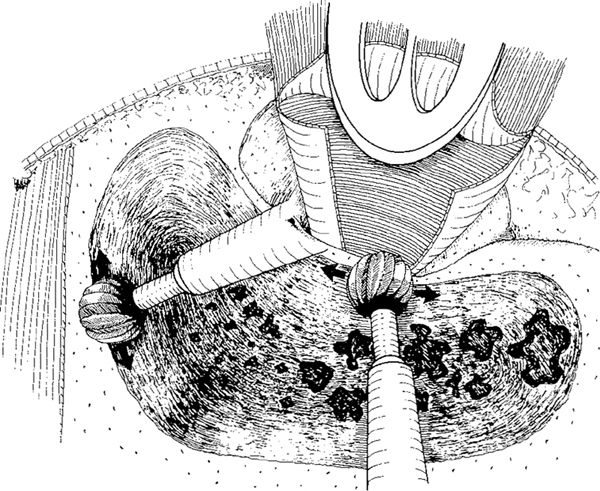
Fig. 128 Correct drilling of the edges by placing the cutting burr perpendicularly on the edge. When the burr is rotated, it moves along the edge, which is the purpose of this type of drilling
Damage to the Ear Canal Skin Flaps
Drilling with a cutting burr within the ear canal, either in retroauricular or endaural approaches, can damage the ear canal skin and tear off the base of a skin flap, especially if it is large, e. g., a Surdille flap in the Shambaugh (1980), Lempert (1941) or Farrior (1968) endaural incisions (Volume 1, pp. 24–33). Some surgeons therefore advocate removal of the ear canal skin as a routine procedure in the endaural approach (Farrior 1968, Wolfermann 1971) and replacement of the skin flaps either in the same place or elsewhere at the end of the operation.
Instead of removing the ear canal skin flaps, the present author prefers the use of a diamond burr within the ear canal when in the vicinity of the canal skin. Protecting the skin flaps by pushing them anteriorly into the anterior tympanomeatal angle, or using retractors with protecting blades, is also a good solution to this problem.
Exposure of the Dura
Exposure of a few square millimeters of the middle fossa dura in the lateral part of the mastoid tegmen (Fig. 62) is sometimes desirable and necessary in order to locate the superior border of the mastoid process. This deliberate small dural exposure is harmless in middle ear surgery, and can easily be performed at an early stage of the mastoidectomy through careful drilling, first with a cutting burr (Fig. 129) and then with a diamond burr. When the compact bone of the middle fossa dura plate is reached, a slightly pinkish coloration can be seen through the bone, caused by dural vessels. After further drilling on this plate, the dura is exposed as a white area, and the level of the mastoid tegmen is located (Fig. 130).
Sometimes, especially with a low-lying dura and attic cholesteatoma, a larger area of the dura at the tegmen antri and tegmen tympani has to be exposed. When one is performing the intact canal wall technique, a very narrow space can be encountered between the bony ear canal—even if it is drilled extremely thin—and the low-lying dura, and the space hampers the view of an attic cholesteatoma (Fig. 131). In such cases, the dura has to be exposed and gently displaced superiorly in order to continue safe drilling toward the attic cholesteatoma (Fig. 131). The bony plate has to be drilled extremely thin using a large diamond burr (Fig. 132). The resulting thin plate can then be fractured by pushing it superiorly (Fig. 133), or partly removed by elevating it gently away from the dura with a broad elevator. The dura, which is now mobilized, can be gently pushed superiorly with the tip of the suction tube, allowing good visibility for further safe drilling of the bony protrusions and spicula using a diamond burr and safe elevation of the cholesteatoma matrix from the thin bony plate of the tegmen tympani (Fig. 134). The result of these efforts will be the safe dissection of the cholesteatoma and a relatively small dural exposure, but with the dura itself remaining intact (Figs. 135, 136). The exposed dura creates a risk of prolapse, but the risk is extremely small, and usually some new bone is formed, reducing or totally covering the exposed area of the dura.
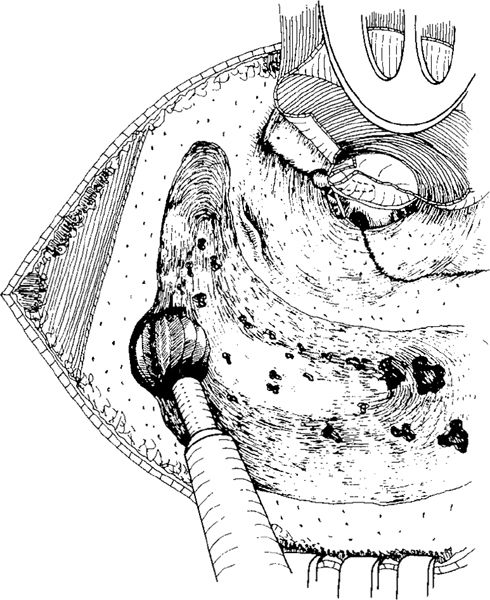
Fig. 129 Exposure of the middle fossa dura at the mastoid tegmen just under the cortical bone, in order to locate the level of the tegmen

Fig. 130 A small area of the dura at the mastoid tegmen is exposed (arrow) in a canal wall–up mastoidectomy situation before penetration of Körner’s septum and entry into the antrum
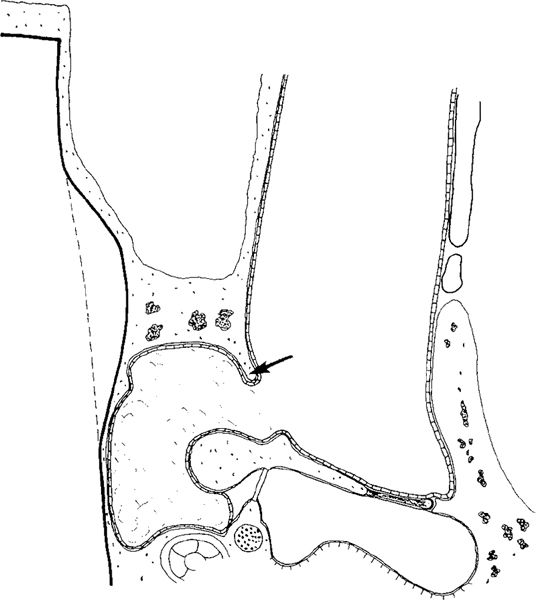
Fig. 131 Side view of an attic cholesteatoma surrounding the malleus head and eroding part of the scutum (arrow) in an ear with a low position of the middle fossa dura, hampering the view for safe removal of the cholesteatoma
It is unusual for exposure and mobilization of the middle fossa dura to be necessary, but it can always be performed as long as the largest possible diamond burrs are used. Perforation of the dura seldom occurs.
In our method of translabyrinthine surgery for acoustic neuroma (Tos and Thomsen 1991), total exposure and mobilization of the entire middle fossa dura and the posterior fossa dura has been performed as a routine procedure in 600 translabyrinthine acoustic neuroma operations. This extended exposure was absolutely necessary in 400 large and giant acoustic neuromas, where mobility of the entire middle fossa dura, the superior petrosal sinus, the sigmoid sinus and the posterior fossa dura is of great benefit during surgery (Fig. 137). It is also helpful in smaller tumors with difficult anatomy, and we have therefore made it a routine procedure to expose the entire dura. Using the largest possible diamond burr, perforation of the middle fossa dura has only occurred very rarely. The middle fossa dural plate can also be fractured with the diamond drill, and can be left attached to the dura at several places.
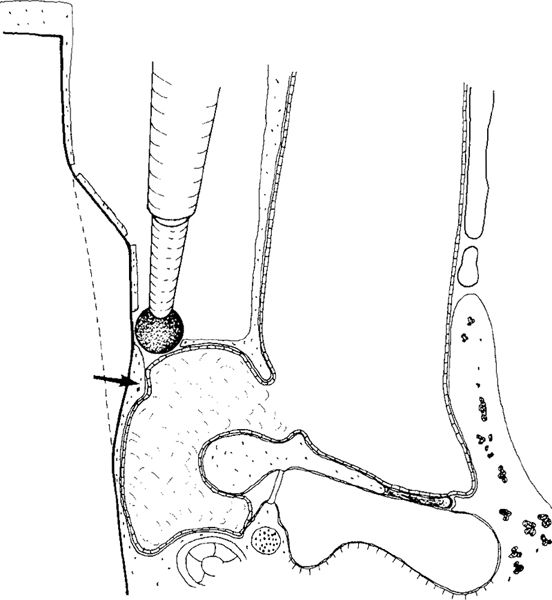
Fig. 132 The bony plate at the mastoid tegmen and tegmen antri is drilled thin with a diamond burr and fractured, allowing partial exposure of a bony overhang (arrow) of the tegmen antri and partial exposure of cholesteatoma matrix
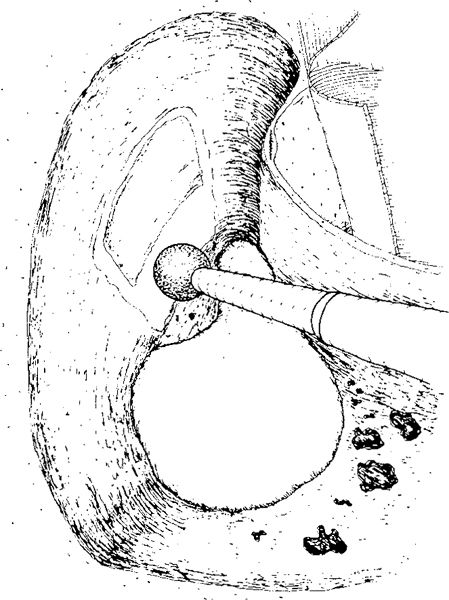
Fig. 133 Intact canal wall mastoidectomy, seen from behind, with an attic cholesteatoma in place. A bony plate of the mastoid tegmen is mobilized. The dura of the tegmen antri and the bony overhang hampering the view to the tegmen tympani are drilled away using a diamond burr
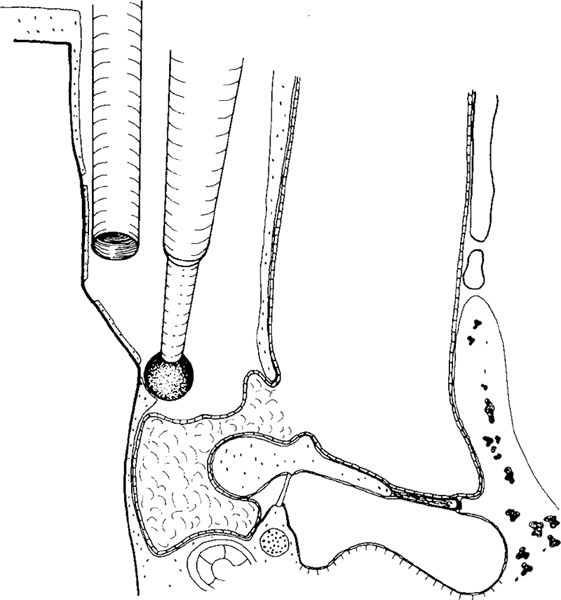
Fig. 134 The mobile dura is gently pushed superiorly with a suction tube, allowing one to drill off the bony overhang
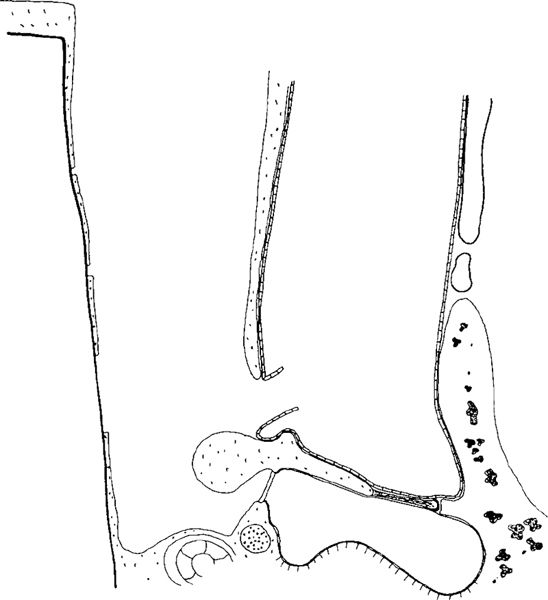
Fig. 135 The Inferiorly positioned middle fossa dura is partly exposed and partly covered with thin bony plates, and the attic cholesteatoma is removed
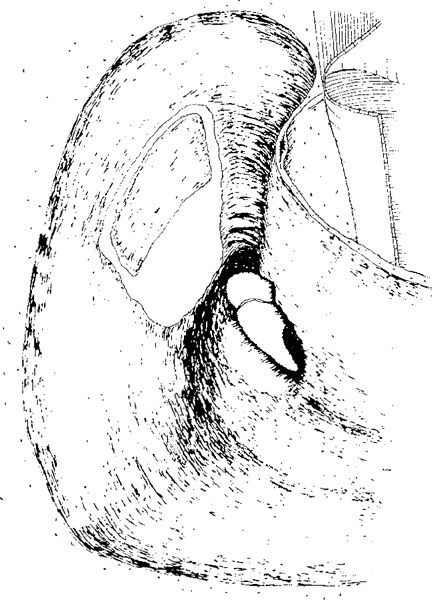
Fig. 136 Canal wall–up mastoidectomy after removal of an attic cholesteatoma with exposure of the dura of the tegmen antri and tegmen tympani. A mobile bony plate is attached to the dura of the mastoid tegmen
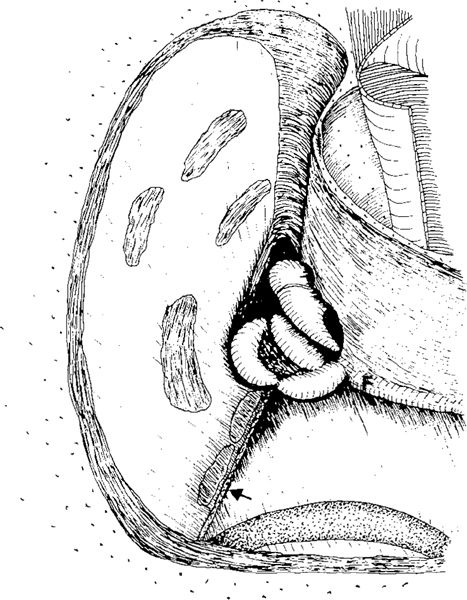
Fig. 137 Total exposure and mobilization of the middle fossa dura, with some islands of thin bony fragments left attached to the dura. The sinus-dura angle with the superior petrosal sinus (arrow) and the posterior fossa dura with the sigmoid sinus, are exposed before labyrinthectomy in the extended translabyrinthine approach for acoustic neuromas. The three semicircular canals are still in place, and the vertical segment of the facial nerve (F) is skeletonized
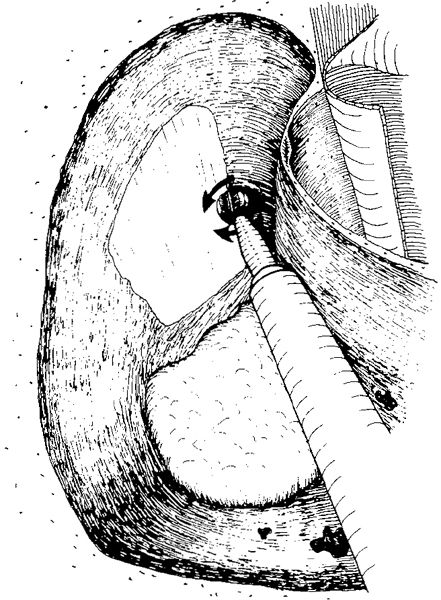
Fig. 138 Perforation of an exposed dura during drilling with a small cutting burr placed incorrectly on the edge of the middle fossa dura plate. There is a cholesteatoma in the attic
Damage to the Middle Fossa Dura
Damage to the dura, including perforation, can accidentally occur if a cutting burr is pressed too hard toward the tegmen mastoidei, antri, or tympani. A small burr simply passes directly through the dura.
Damage also occurs if a cutting burrr is used with excessive pressure directed onto an edge of the bone (Fig. 138). The burr can jump off the bone through the exposed dura and into the middle fossa, with damage to the arachnoids and the surface of the temporal lobe itself.
A large cutting burr, moved gently in an anteroposterior direction over the bony plate of the mastoid tegmen, usually does no harm, but it may not be particularly efficient. It is therefore better to use a large diamond burr. A diamond burr with a high rotation speed can be as effective as a cutting burr, but much less dangerous and thus more “relaxing” to use. Using a burr of less than 2 mm in diameter will always involve a risk of perforation of the dura. A small diamond burr should be used with particular care, and especially without pressure on the dura. On the other hand, in translabyrinthine surgery, the space between the middle fossa dura plate medial to the superior petrosal sinus and the superior wall of the internal auditory meatus is narrow, and only small diamond burrs can be used here. Perforation of either the middle fossa dura or the meatal dura is common.
As well as burrs (cutting and diamond), damage to the dura can occur with other instruments, e. g., chisels or other sharp instruments perforating the dura.
When a perforation of the dura is recognized, with or without a cerebrospinal fluid leak, peroperative prophylactic intravenous penicillin is advisable, and the region should not be manipulated until the end of the operation, when the dural perforation should be closed.
Repair of Dural Defects
In acoustic neuroma surgery or other skull base surgery in which obliteration of the cavity with fatty tissue is employed, a perforation of the middle fossa dura lateral to the superior petrosal sinus is usually sealed by the fatty tissue itself, and antibiotic treatment is not necessary for this complication alone. The posterior fossa dura is opened in acoustic neuroma surgery anyway.
In middle ear surgery, the operative field is potentially infected, and a tear in the dura represents a complication that should be treated.
After ensuring that no cholesteatoma membrane has spread into the cranial fossa during the dural penetration and that no cholesteatoma is adherent to the dura or to the bony plate of the tegmen, the region should not be interfered with during the subsequent surgery. The dural defect is repaired near the end of the procedure, after the mastoidectomy has been completed and the ossiculoplasty and myringoplasty have been performed.
A small tear of the dura with no defect, resulting in spontaneous closure of any cerebrospinal fluid leak peroperatively, can be further secured with a curved bipolar diathermy forceps, ensuring permanent closure of the cerebrospinal fluid leak (Fig. 139). In order to ensure even more secure closure, a piece of temporalis muscle fascia can be placed over the exposed dura and secured with fibrin glue.
With larger defects of the dura, closure is brought about by temporalis muscle fascia using a “triple seal” of the defect. Firstly, the defect is sealed using fibrin glue in such a way that a small amount of the glue is placed within the defect but the majority outside it, hence creating a fibrin glue collar button or cork (Fig. 140). The sealed defect is then covered with temporalis muscle fascia, which is gently pushed under the edge of the bone all the way around the dural exposure, creating a second seal (Fig. 141). The third seal is achieved by further gluing of the fascia to the edges to the bone (Fig. 142). This triple seal usually requires no further covering or obliteration of the cavity.
If there is any doubt about the stability of the seal, obliteration of the cavity, with further placement of periosteum, fibrous tissue, fascia, or a pedicled subcutis–muscle flap will be required. The obliteration can be performed in both canal wall–up or canal wall–down mastoidectomy.
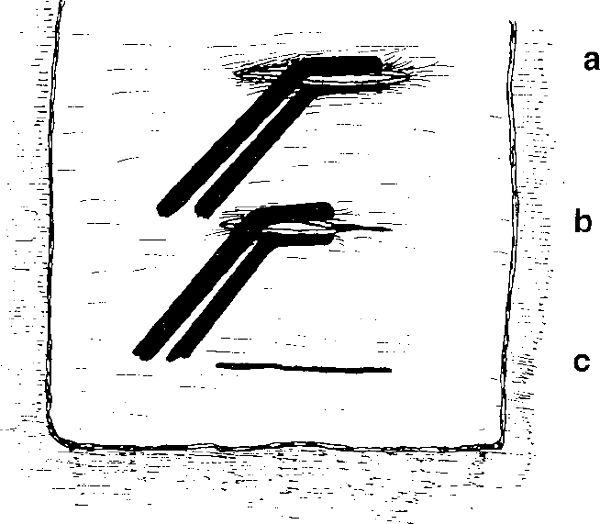
Fig. 139 Closure of a small dural defect with bipolar coagulation.
a A large curved bipolar pincette is placed on the small dural tear, the first coagulation gluing the two edges together.
b The final coagulation.
c The tear is solidly coagulated and closed
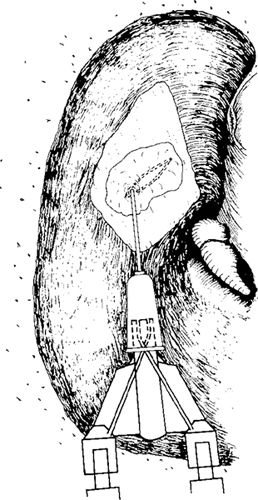
Fig. 140 Closure of a dural defect with fibrin glue and fascia. The dural defect (dashed line) is covered with fibrin glue placed in the defect so that it covers the defect both from inside and outside

Fig. 141 A piece of the temporalis muscle fascia is placed under the bony edges, covering the entire dural exposure and the fibrin glue. After the last edge of the dura is placed under the bone with the curved elevator, further sealing is carried out around the bony edges
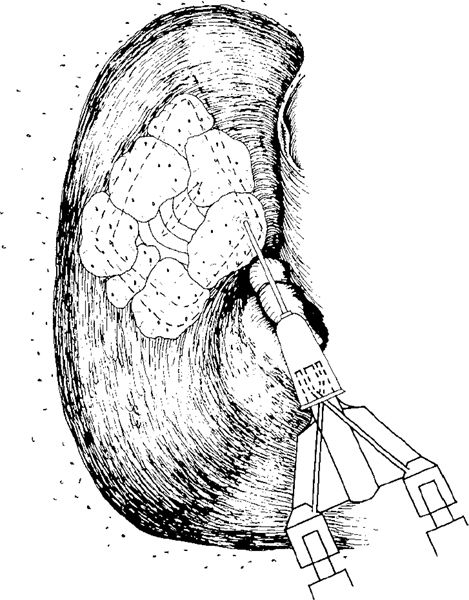
Fig. 142 The fascia is further glued to the edge of the bony defect, providing triple sealing of the defect
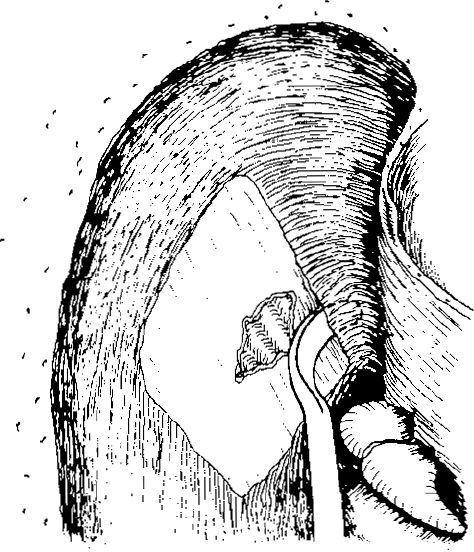
Fig. 143 Closure of a large dural defect with a cartilage plate. The dura is elevated from the bone all the way around the exposure using a curved elevator

Fig. 144 A slightly convex conchal cartilage plate is placed between the bone and the dura, with its convex surface pointing toward the cortex

Fig. 145 The cartilage and bone edges are covered with fibrine glue, and the bone from the tegmen is covered with fascia and glued

Fig. 146 Dural closure (side view). The cartilage plate is placed between the dural layer and the bone, covered with fibrin glue, and again covered with fascia and fibrin glue
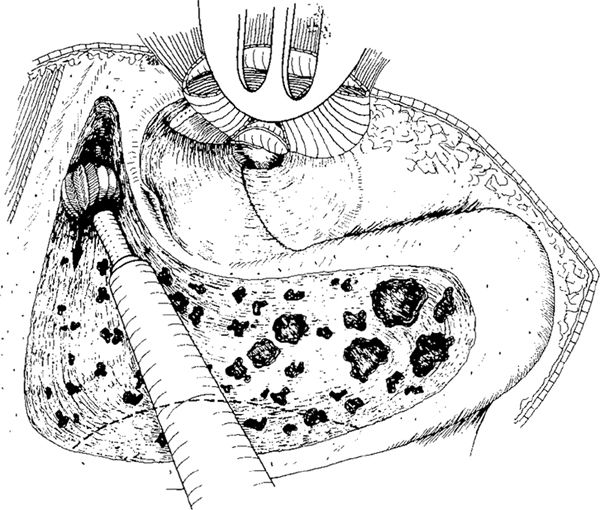
Fig. 147 Skeletonizing the mastoid tegmen in a canal wall–up mastoidectomy in an ear with a well-pneumatized mastoid process. The cortex has been widely removed. Using a large cutting burr, the tegmental cells are exenterated by moving the burr in a posterior direction. The ear canal is exposed by elevating the skin flaps and protecting them with the protective blade of the House–Sheehy retractor. The tympanosguamous suture is visible superiorly and the tympanomastoid suture inferiorly in the ear canal
In larger defects of the dura resulting in cerebrospinal fluid leakage, a more substantial type of tissue than fascia should be used to cover the defect. Conchal or tragal cartilage can be placed between the dura and the bone after elevation of the dura from the bony plate (Fig. 143). The slightly convex conchal cartilage is placed between the bone and the dura with the convex surface towards the dura. The dura is thus pushed slightly inward and stretched, providing better contact between the cartilage and the dura (Fig. 144). The surfaces of the cartilage, the dura, and the bone edges are all covered by a layer of fibrin glue. Finally, a large piece of fascia is placed on the bone of the tegmen and secured with fibrin glue (Figs. 145, 146), providing a triple seal. It is wise to obliterate the cavity with autogenous tissues, such as a pedicled subcutis–muscle flap, or other available tissue.
Avoidance of Dural Lesions
To avoid perforation of the middle fossa dura during drilling, the following precautions should be taken into consideration during drilling on the middle fossa dura plate:
1. Obtain extensive lateral exposure through a sufficiently wide approach to the mastoid process (Fig. 147).
2. Use a large burr whenever possible. It is best to use the largest cutting burr along the middle fossa dural plate.
3. Avoid running the burr across the bone edge.
4. Use light pressure intermittently.
5. Avoid continuous pressure on the dural plate (Fig. 147).
6. Drill with a “light hand,” holding the handpiece like a pen.
7. Use the side of the burr as a cutting edge, rather than its head.
8. Proceed slowly along the middle fossa dural plate (Fig. 148), removing the bridges between air cells where present.
9. Sometimes large air cells extending up to the mastoid tegmen are present, and the bony plate covering the dura at these points may be very thin. It is therefore best to use intermittent pressure, keeping the middle fossa dural plate in view constantly.
10. Use constant irrigation during drilling in order to maintain a good view of the bone at all times.
11. Don’t use the burr blindly in small holes; keep the field as wide as possible.
12. If you are in doubt as to the level of the mastoid tegmen, expose the dura laterally (Figs. 129, 130).
13. After the tegmental cells have been removed and the bony dural plate has been located, it is safest to change to a large diamond burr and polish the mastoid tegmen as far as to the Körner’s septum.
Exposure of the Sigmoid Sinus
In middle ear surgery, deliberate exposure of the sigmoid sinus is seldom necessary. Usually, good skeletonization is enough to provide an adequate view of the mastoid process in order to remove cholesteatoma or other pathology. With an anteriorly positioned sinus and a very short distance between the posterior border of the bony external auditory canal and the anterior sinus wall, partial, or sometimes even total, displacement of the most prominent part of the sinus is necessary in order to remove cholesteatoma medial to the sinus. Before such displacement, exposure of the sinus is necessary.
In skull base surgery, total exposure of the sinus is routine for most approaches. In our extended translabyrinthine approach for large and giant acoustic neuroma tumors (Tos and Thomsen 1991), total exposure of the sigmoid sinus from the transverse sinus to the jugular bulb is a routine procedure. The cortical bone is also removed posterior to the sinus, in order to push the sinus posteriorly. In translabyrinthine surgery for small acoustic neuromas, we always thoroughly skeletonize the sigmoid sinus, even if it is posteriorly positioned. In all other cases, the sinus is totally exposed.

Fig. 148 The tegmental cells are removed, exposing the bony plate of the mastoid tegmen. From the sinodural angle, the cutting burr is moved in an inferior direction to exenterate the perisinusal cells
In endolymphatic sac surgery, exposure of the sinus is a routine procedure, since the sac is more easily and safely found by exposing and posteriorly displacing the sigmoid sinus. A knowledge of the methods of sinus exposure and associated complications can make the ear surgeon more confident when performing mastoidectomy, allowing for faster surgery in this region.
After extensive removal of the cortical bone and wide exposure of the lateral aspect of the mastoid process (Fig. 147), the mastoid tegmen and the sinodural angle are identified (Fig. 148). Exenteration of the air cells anterior and lateral to the likely position of the sigmoid sinus is started in a superoinferior direction (Fig. 149). With a large cutting burr, light and intermittent pressure is applied with constant irrigation, allowing visualization of a blue discoloring of the bone. As long as the bony septa of air cells are present without the blue color of the underlying bone, drilling can continue with a large cutting burr (Fig. 150), still moving it in a superoinferior direction along the course of the sigmoid sinus. The lateral sinus cells, if present, are removed, resulting in smooth bone appearing over the entire lateral and anterior surfaces of the sinus (Fig. 150).
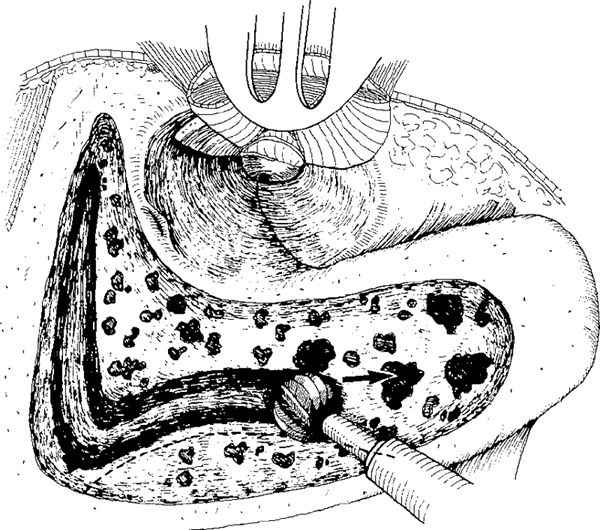
Fig. 149 The perisinusal cells are exenterated by moving the large cutting burr in the superoinferior direction, carefully observing the bluish color of the bone covering the sinus
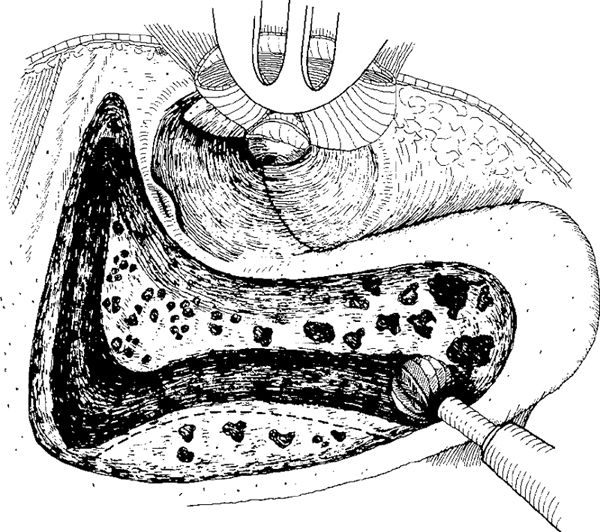
Fig. 150 The burr is moved further inferiorly, exenterating the apical air cells
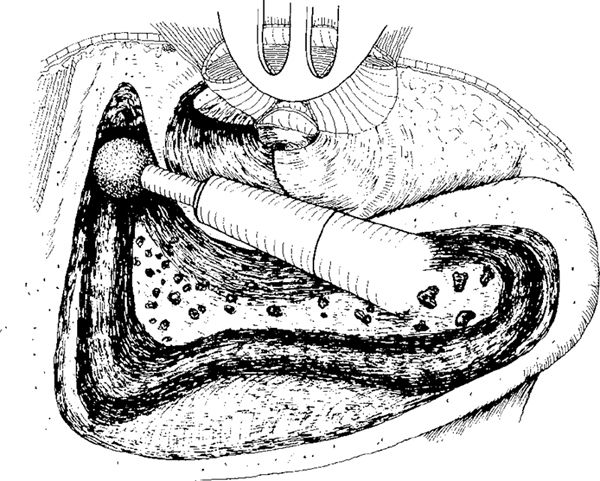
Fig. 151 By gradually removing the bone from the middle fossa dura plate, the sigmoid sinus, and the posterior fossa dura plate using a large diamond burr, the air cells are exenterated, exposing Körner’s septum
Further skeletonization of the sinus depends on the situation. If the space created is large enough to remove disease medial to the sigmoid sinus, the antrum, and the anterior attic, no further skeletonization is needed. The surface of the sinus is polished with the largest diamond burr, and after further polishing of the middle fossa dura plate down to Körner’s septum and of the posterior canal wall, the cavity is gradually enlarged (Fig. 151).
If the space created is narrow, as it is in an anteriorly positioned sinus (Fig. 152), and if the pathology requires the displacement of the sigmoid sinus, the sinus must be exposed by careful removal of bone (Figs. 153, 154) and protected by the suction tube during the further removal of underlying bone and subsequent dissection of the cholesteatoma (Fig. 155).
There are several methods of exposing the sigmoid sinus: 1) creation of “Bill’s island,” 2) the eggshell method, and 3) total bone removal or total exposure of the sinus.
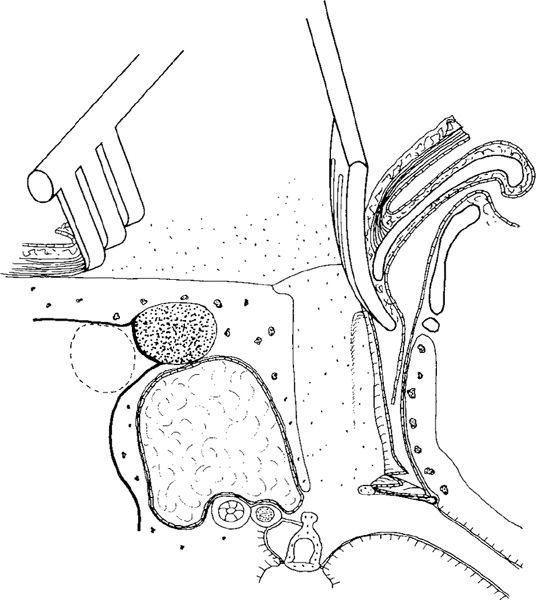
Fig. 152 Perspective side view of an anteriorly positioned sigmoid sinus in a case of attic cholesteatoma, concealed medial to the sinus, which cannot safely be removed without displacement of the sinus posteriorly, toward the dashed line

Fig. 153 The cortical bone from the sigmoid sinus is drilled away, leaving the posterior bony wall of the ear canal intact. The anterior or medial surfaces of the bony wall of the sinus are exposed using a diamond drill
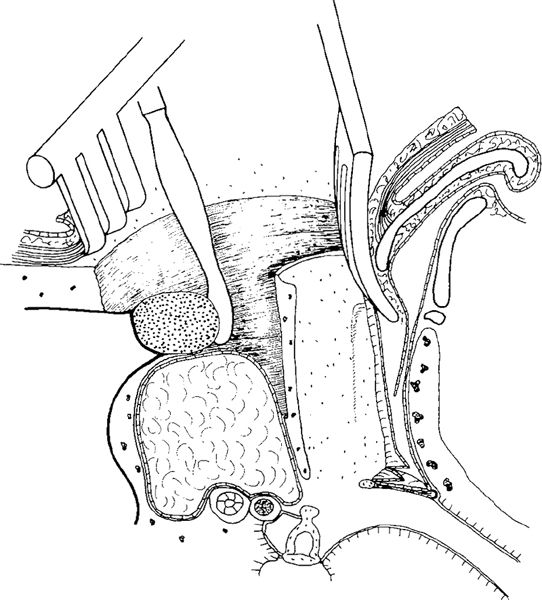
Fig. 154 The totally exposed sigmoid sinus can be gently pushed posteriorly, and the drilling of its medial wall can continue
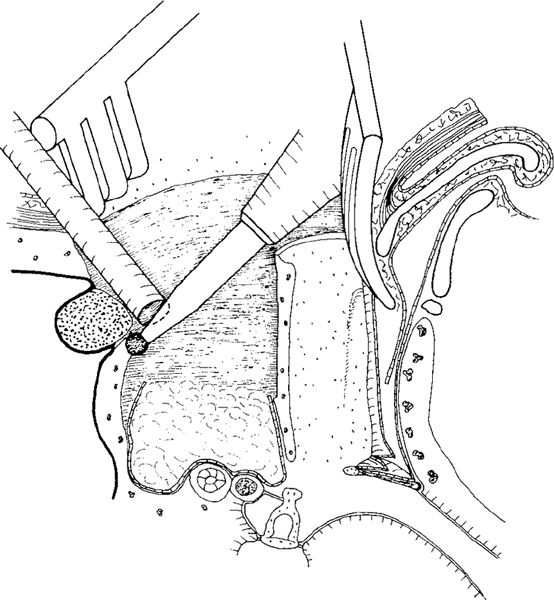
Fig. 155 The sinus is exposed, displaced posteriorly, and protected by the suction tube during further drilling of its medial wall and during dissection of the cholesteatoma membrane from the bone. The lateral part of the cholesteatoma has already been removed

Fig. 156 Formation of Bill’s island. The sigmoid sinus is positioned anteriorly, and a canal wall–up mastoidectomy technique is being employed after exenteration of the lateral mastoid air cells. The sinus has been skeletonized. K: Körner’s septum
Bill’s Island Method
When performing translabyrinthine surgery, Bill House drilled an island of bone over the most prominent part of the sigmoid sinus, mobilizing and then pushing it posteriorly (House and Luetje 1979). First, the sinus bone should be skeletonized using a large diamond burr to a thickness of 0.5 mm of bone (Fig. 156). Then a groove is carefully drilled circumferentially around the most prominent part of the bone with a 1-mm diamond burr, exposing a strip of sinus all the way around (Fig. 157). The island of bone is then fractured and pushed posteriorly, and can be held in this position by a suction tube. The anterior part of the bone can then be safely drilled using a large diamond burr (Fig. 158). The bone from the superior part of the sinus prominence is then drilled (Fig. 159). Finally, the inferior part of the bony prominence is drilled whilst exposing the sinus and pushing it posteriorly (Fig. 160). This method is not easy to perform. The burr used for drilling out the island should be small, and there is some danger to the sinus wall. The idea of the island is to protect the sinus during later manipulation, but the island can tilt on its edge, and the edge can then damage the sinus wall.

Fig. 157 A groove is drilled around the prominent part of the sinus using a small diamond burr, creating a Bill’s island
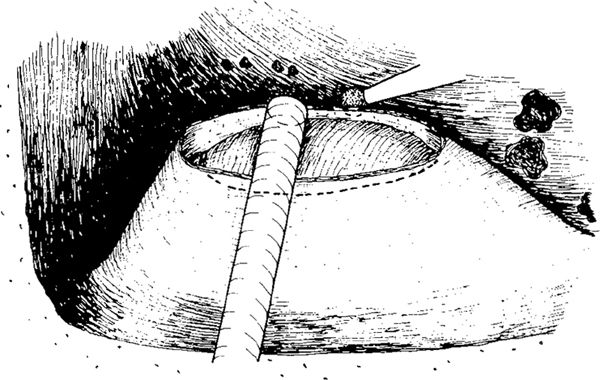
Fig. 158 The Bill’s island is depressed and held in place by a suction tube. The bone situated anteriorly to the sinus, forming the edge between the sinus and the dura, can now be removed by further drilling with a large diamond drill
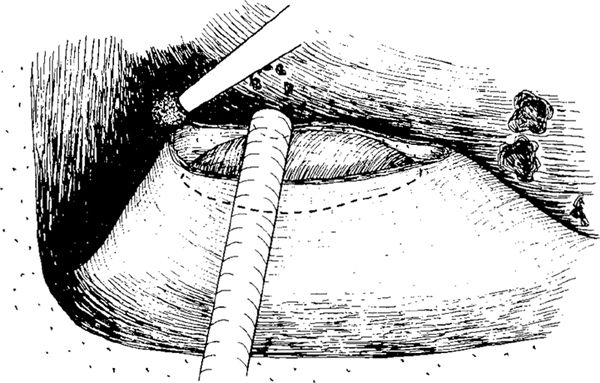
Fig. 159 Drilling of the bone is continued superiorly along Bill’s island, exposing the superior part of the sigmoid sinus
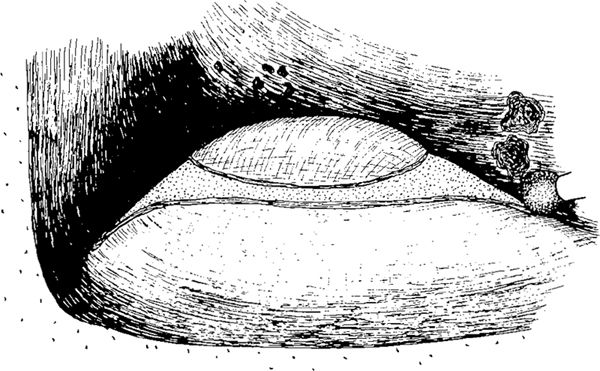
Fig. 160 The sigmoid sinus is now exposed, and the Bill’s island is still attached to the sinus wall
The Eggshell Method
The author almost exclusively employs this method, the principle being to drill the entire sinus wall as thin as possible with a large diamond burr before fracturing it. This is achieved by continuous drilling of the bone covering the sinus, skeletonizing it to such a degree that the periosteum and the thin bony shell are fractured into several small pieces during the drilling with a large diamond burr gradually. These small islands of thin bone remain attached to the sinus (Fig. 161). The sigmoid sinus wall is now compressible, either using a suction tube or a Freer’s rougine (Fig. 162). By pushing the superior part of the sinus back using the suction tube, the bone lying medial to the sinus can now be safely drilled, still using the eggshell method (Fig. 163). Drilling continues along the sinus inferiorly (Fig. 164), still pushing the compressible sinus back from the bone with the suction tube. After completing the skeletonization of the sinus using the eggshell method, the sinus may be totally exposed in some parts because some of the islands of bone become detached from the sinus, but the majority of the compressible thin bone covering the sinus will still protect it (Fig. 165).
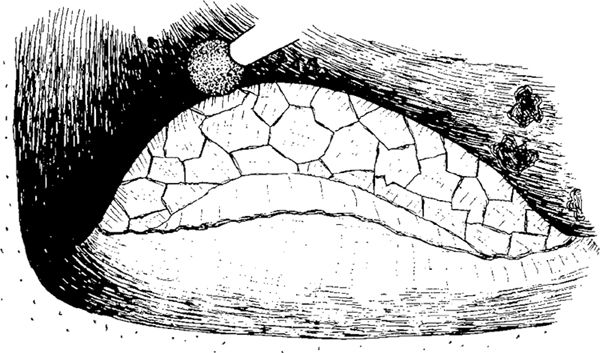
Fig. 161 The eggshell method of skeletonizing the sigmoid sinus. Using a large diamond drill, the bone covering the sigmoid sinus is continuously drilled thin, and finally fractured, forming many small bony islands with an eggshell appearance
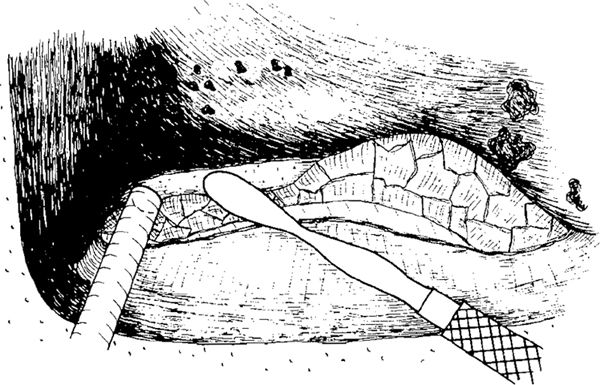
Fig. 162 The sinus is now compressible with a suction tube or a Freer’s rougine, and the bone around the sinus can be drilled away
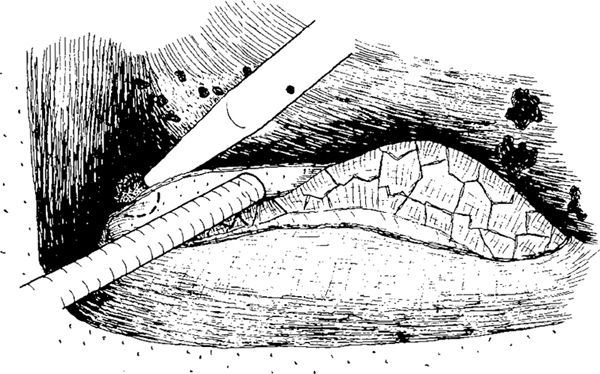
Fig. 163 The bone is drilled thin superiorly. The sinus is protected by a suction tube
Stay updated, free articles. Join our Telegram channel

Full access? Get Clinical Tree


